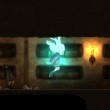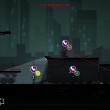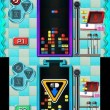[Other Take] Strike Suit Zero: Director’s Cut Review
Strike Suit Zero: Director's Cut is pushy. This space shooter all but wrecks its occasionally thrilling dogfighting action by never, ever knowing when enough is enough. The game is a prime example of kitchen-sink game design, assuming that if one white-knuckle tumble against a dozen enemy spaceships is good, then waging that exact same battle many times in succession during each and every mission must be flat-out fantastic. In reality, of course, this relentless approach chafes. It wears at your patience almost from the very beginning, to the point where the monotony soon makes you long to do something livelier.
The premise is a traditional space opera saga. The year is 2299, and you play a voiceless spaceship jockey named Adams, who gets into the civil war raging between Earth and rebellious human colonies just as the colonials are about to go all Death Star on the homeworld. The story is intriguing; not everything is spelled out in the beginning, leaving a lot of open questions about the mysterious alien tech that sparked the war, as well as about your fascinating allies, one of which is an enigmatic humanlike AI. There is no shortage of tension created by the threat to Earth--tension dramatically underlined in the fiery remains of a planet that serves as the backdrop to the campaign's second mission.
Most of the time, Strike Suit Zero is content to be a modern take on the familiar space shooter, with design tropes that go back to Wing Commander. You take to the spacelanes in the cockpits of various vessels, and upgrade and unlock weapons, armor, and other gear as you move through missions. Controls are easy to grasp: The sticks control roll, pitch, and yaw, while the buttons handle shooting, acceleration and deceleration, and firing off missile-diverting chaff. The feel isn't quick flightstick-precise, although the accuracy is close enough to fend off any frustration. The overly simplistic targeting is the only real problem, as you often need to cycle through lengthy lists of foes to choose the one that you want to attack.
You also gain access early on to the strike suit, a Transformers-styled variety of ship that can morph into a giant robot whenever you blast enough enemies and power supplies like drones to load up on an energy source called flux. The character of the game changes as soon as you make the switch, as you immediately go from flying around Rogue Squadron-like to a good re-creation of Optimus Prime standing still in space. Whenever you transform, you lose all maneuverability and speed aside from a weird sidestep that seems entirely out of place, but gain the ability to unload huge energy blasts and twisting waves of missiles that obliterate enemy capital ships.
![[Other Take] Strike Suit Zero: Director's Cut Review](https://gamenetwork.eu/files/2014/04/2040167-716406_20130521_004.jpg)
Predictably, morphing into a battlemech can be effective, especially when facing waves of enemy fighters, and it's satisfying to pull a "watch this" moment and shred enemy squadrons in seconds. But the Transformers angle doesn't mesh well with high-speed dogfighting. One moment you're looping and spinning at speeds that would snap a spine; the next you're locked in place like a Big Bertha, mindlessly firing round after round at every nearby foe. Becoming a giant robot always comes with some regret, as it brings the entire game to a crashing halt.
What drops Strike Suit Zero back to zero most of all, however, is tedious combat. Every one of the 13 scenarios in the main campaign and the further half-dozen or so offered up as part of the additional Heroes of the Fleet mission series (sold separately as DLC when the game was released for the PC last year) does everything but beat you into submission with a Megatron action figure. Objectives rarely vary from escort missions, seemingly eternal dogfights, and straightforward assaults. In all mission types, enemy ships keep coming, and coming, and coming, warping in many times after you think the mission is finally over, like some intergalactic take on Halloween's Michael Myers. Sheer enemy numbers overwhelm the interface. Tracking colonial ships is a real challenge in battles, as the screen is always littered with red arrows pointing offscreen to every threat and piece of random space junk. Your battle cry soon becomes "Enough already!"
![[Other Take] Strike Suit Zero: Director's Cut Review](https://gamenetwork.eu/files/2014/04/2040165-716406_20130521_002.jpg)
Most of Strike Suit Zero is stripped down in comparison to more lavish space shooters of days gone by. There are no extravagant load-out option screens, no recreation decks to relax in with your fellow pilots, or even animations during the mid-mission visual transmissions from allied vessels (in the future, everyone is apparently a ventriloquist). The main plus here is being able to play from either a first-person cockpit point of view or from an external trailing camera. Ship models are bland, with little in the way of detail, and mission backdrops are mostly static scenes that are stylish and atmospheric, but still limited in impact, like the matte paintings in old Star Trek episodes. This is a plain Jane game made up for the prom.
Only the soundtrack rises above the waterline of mediocrity here, thanks to futuristic tunes that come off like mash-ups of the musical scores from Blade Runner and the reimagined Battlestar Galactica. There is a vaguely Eastern vibe to the music, along with echoing choral odes and never-quite discernible chants of exotic words. The only odd thing about the music is its slightly distant sound. Instead of being front and center in the mix like the usual game soundtrack, the score here is somewhat buried, as if you were cruising around listening to the universe's top 40 station on the FM dial.
Sometimes, simple is better. Maintaining focus on frantic space battles that move quickly and wrap up before you have time to regret what you're playing would have made Strike Suit Zero: Director's Cut more energetic and compelling. Piling on enemies and tossing in the Transformers-inspired ship just clogs up what could have been a charming, if deeply predictable, space shooter.
Space combat veteran Brett Todd played with his Transformer space ships in Strike Suit Zero: Director's Cut for over a dozen hours.








